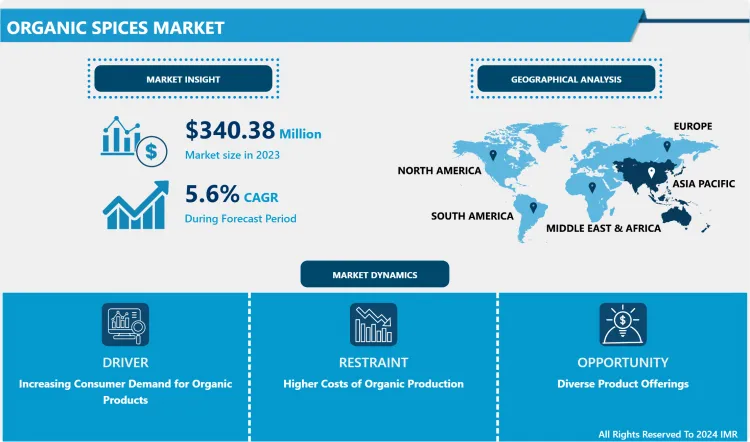Organic Spices Market Synopsis
Global Organic Spices Market Size Was Valued at USD 340.38 Million in 2023, and is Projected to Reach USD 555.83 Million by 2032, Growing at a CAGR of 5.6% From 2024-2032.
- Organic spices are nothing but the seeds, leaves, barks, dried fruits and roots which is used for medicinal purpose and especially for cooking purpose to add the flavor, aroma and color to the food. The spices are introduced by India to the global level market which tends to boost the growth of the market in Asia Pacific region. Several spices are available in the form of powder, whole and chopped forms. Most of the used spices are Chili powder Cumin, Coriander, Cinnamon, Cardamon, Ginger, and Turmeric.
- Black pepper is primarily used worldwide and accounted for the largest share in the global spice market. The modern day use of spices is limited to taste and flavor but they are extensively used for their health benefit thus influencing the growth of the organic spice market during the forecast period. For instance, Turmeric helps as internal and external application such as it is used to manage diabetes by lowering blood glucose level, reduces complications like ulcer, wounds, kidney damage and skin problems.
- Spices are being used as flavoring agent, coloring agent, or as a preservative in different types of food products. Cardamom, clove, black pepper, cumin, coriander seeds, mustard seeds, fenugreek, turmeric, and saffron are some of the spices that are witnessing considerable growth in the global market. Asia-Pacific region has witnessed higher rate of consumption for these spices, owing to rise in demand and preference for spicy food in the region. Asia-Pacific is also the main producer and exporter for different types of spices.


Organic Spices Market Trend Analysis
Increasing Consumer Demand for Organic Products
- Consumers are becoming more health-conscious and are actively seeking food products that are perceived as healthier and more natural. Organic spices, being free from synthetic pesticides and chemicals, align with the preferences of health-conscious consumers.
- Many organic spices are known to have nutritional benefits, including antioxidant properties and potential anti-inflammatory effects. Consumers are increasingly aware of these health benefits and are incorporating organic spices into their diets for both flavor and wellness.
- Consumers are more environmentally conscious and are choosing products that are produced through sustainable and eco-friendly practices. Organic farming methods, which avoid synthetic chemicals, are considered more sustainable, leading to an increased demand for organic spices.
- Organic products are often associated with higher quality and purity. Consumers perceive organic spices as being free from artificial additives and chemicals, leading to a preference for these products over conventional counterparts.
- Growing concerns about food safety, including pesticide residues in conventional products, drive consumers to choose organic options. Organic spices offer a safer alternative, as they are produced without the use of synthetic pesticides and herbicides.
Diverse Product Offerings
- Consumers have diverse culinary preferences, influenced by regional cuisines, cultural backgrounds, and personal tastes. Offering a wide range of organic spice products allows businesses to cater to this diversity and appeal to a broader customer base.
- There is a growing interest among consumers in exploring exotic and specialty spices from different parts of the world. Organic spice producers can capitalize on this trend by offering unique and hard-to-find spices, providing consumers with an opportunity to experiment with new flavors.
- Developing signature spice blends that are exclusive to a brand adds a unique selling proposition. These blends can be curated for specific dishes or cuisines, offering convenience to consumers and reinforcing brand identity.
- Diverse product offerings can include spice blends that cater to specific dietary preferences, such as low-sodium, gluten-free, or vegan options. Additionally, creating blends with health-focused ingredients can align with current wellness trends.
- Introducing seasonal or limited edition organic spice blends creates a sense of exclusivity and urgency among consumers. These offerings can coincide with holidays, festivals, or special occasions, encouraging repeat purchases.
Organic Spices Market Segment Analysis:
Organic Spices Market Segmented on the basis of Product Type, Application, Form and Distribution Channel.
By Product Type, Turmeric segment is expected to dominate the market during the forecast period
- Turmeric contains curcumin, a compound with potential health benefits, including anti-inflammatory and antioxidant properties. Increased consumer awareness of these health benefits has driven demand for organic turmeric.
- Turmeric is a staple in many global cuisines, especially in South Asian and Middle Eastern dishes. Its versatility makes it a popular choice for consumers looking to enhance the flavor and color of their dishes.
- Turmeric has a long history of use in traditional medicine, particularly in Ayurveda. The growing interest in natural remedies and traditional healing practices has contributed to the popularity of organic turmeric.
- With a rising emphasis on natural and organic products, consumers are seeking alternatives to conventional spices. Organic turmeric aligns with this trend, as it is grown without synthetic pesticides and chemicals.
- Turmeric has found its way into various functional food and beverage products, including turmeric-infused teas, lattes, and health supplements. This diversification of turmeric products has expanded its market presence.
By Form, Powder segment held the largest share of 41.17% in 2022
- Powdered products are often versatile and can be used in various applications. They might be easier to formulate for different purposes, making them more appealing to a broad audience.
- Powders tend to have a longer shelf life and can be more stable than some other forms, such as liquids. This can be advantageous for both consumers and manufacturers.
- Ease of Transportation and Storage: Powders are often more compact and lightweight than liquids, making transportation and storage more cost-effective. This can be particularly important for products that need to be shipped over long distances.
- Powders can be easier to customize in terms of concentration or dosage. Consumers may appreciate the ability to control the strength or amount of the product they use.
- Manufacturing processes for powders may be more efficient, leading to cost savings for producers. This efficiency can contribute to a more competitive pricing strategy.
Organic Spices Market Regional Insights:
Asia Pacific is Expected to Dominate the Market Over the Forecast period
- Many countries in the Asia Pacific region have favorable climates and natural conditions for growing spices. Organic farming practices are often more easily implemented in regions where the climate is conducive to the cultivation of spices without the need for excessive synthetic inputs.
- Some countries in Asia Pacific have a long history of traditional farming practices that align with organic principles. Farmers in these regions may have been using organic methods for generations, making the transition to certified organic farming relatively seamless.
- Asia Pacific is known for its diverse and rich culinary traditions, with spices playing a crucial role in many cuisines. This cultural significance may drive both the demand for organic spices within the region and the production to meet this demand.
- As global awareness of health and environmental issues grows, there has been an increased demand for organic and sustainable products. Consumers in the Asia Pacific region may be increasingly aware of the benefits of organic spices, both in terms of personal health and environmental sustainability.
- Some countries in the Asia Pacific region, such as India and Vietnam, are major exporters of spices. The demand for organic spices in international markets, including Europe and North America, has contributed to the growth of the organic spices market in the region.
Organic Spices Market Top Key Players:
- Frontier Co-op (US)
- Organic Spices Inc. (US)
- Earthy Delights (US)
- The Spice Hunter (US)
- Organic Wise (US)
- McCormick & Company, Inc. (US)
- Naturevibe Botanicals (US)
- Rising Sun Farms (US)
- Organic Gemini (US)
- Pure Indian Foods (US)
- Mountain Rose Herbs (US)
- SunOpta Inc. (Canada)
- Simply Organic (US)
- Pacific Spice Company, Inc. (US)
- Live Organic (India)
- Earl's Organic Produce (US)
- Spice Sanctuary (Canada)
- Greenfields (UK)
- Sambavanilla (Madagascar)
- Organic Products India (India)
- Yogi Botanicals Pvt. Ltd. (India)
- Organic Tattva (India)
- BiovaGaya Biotech Pvt Ltd (India)
- Organic Spices (India)
- Sunrise Nutrachem Group (China), and Other Major Player
Key Industry Developments in the Organic Spices Market:
In October 2023, Frontier Natural Products, a leading organic spice player, expands its offerings with a new line of single-origin organic turmeric sourced directly from Indian farmers. This move aims to tap into the growing demand for ethical sourcing and traceability.
In September 2023, McAvoy Foods, a major spice distributor, announces a partnership with Organic Spices Inc. to launch a line of certified organic spice blends. This collaboration caters to the rising interest in convenience and flavor exploration among home cooks
|
Organic Spices Market |
|||
|
Base Year: |
2023 |
Forecast Period: |
2024-2032 |
|
Historical Data: |
2017 to 2023 |
Market Size in 2023: |
USD 340.38 Mn. |
|
Forecast Period 2024-32 CAGR: |
5.6 % |
Market Size in 2032: |
USD 555.83 Mn. |
|
Segments Covered: |
By Product Type |
|
|
|
By Application |
|
||
|
By Form |
|
||
|
By Distribution Channel |
|
||
|
By Region |
|
||
|
Key Market Drivers: |
|
||
|
Key Market Restraints: |
|
||
|
Key Opportunities: |
|
||
|
Companies Covered in the report: |
|
||
Chapter 1: Introduction
1.1 Research Objectives
1.2 Research Methodology
1.3 Research Process
1.4 Scope and Coverage
1.4.1 Market Definition
1.4.2 Key Questions Answered
1.5 Market Segmentation
Chapter 2:Executive Summary
Chapter 3:Growth Opportunities By Segment
3.1 By Type
3.2 By Form
3.3 By Application
Chapter 4: Market Landscape
4.1 Porter's Five Forces Analysis
4.1.1 Bargaining Power of Supplier
4.1.2 Threat of New Entrants
4.1.3 Threat of Substitutes
4.1.4 Competitive Rivalry
4.1.5 Bargaining Power Among Buyers
4.2 Industry Value Chain Analysis
4.3 Market Dynamics
4.3.1 Drivers
4.3.2 Restraints
4.3.3 Opportunities
4.5.4 Challenges
4.4 Pestle Analysis
4.5 Technological Roadmap
4.6 Regulatory Landscape
4.7 SWOT Analysis
4.8 Price Trend Analysis
4.9 Patent Analysis
4.10 Analysis of the Impact of Covid-19
4.10.1 Impact on the Overall Market
4.10.2 Impact on the Supply Chain
4.10.3 Impact on the Key Manufacturers
4.10.4 Impact on the Pricing
Chapter 5: Organic Spice Market by Type
5.1 Organic Spice Market Overview Snapshot and Growth Engine
5.2 Organic Spice Market Overview
5.3 Cumin
5.3.1 Introduction and Market Overview
5.3.2 Historic and Forecasted Market Size (2017-2032F)
5.3.3 Key Market Trends, Growth Factors and Opportunities
5.3.4 Cumin: Grographic Segmentation
5.4 Coriander
5.4.1 Introduction and Market Overview
5.4.2 Historic and Forecasted Market Size (2017-2032F)
5.4.3 Key Market Trends, Growth Factors and Opportunities
5.4.4 Coriander: Grographic Segmentation
5.5 Cloves
5.5.1 Introduction and Market Overview
5.5.2 Historic and Forecasted Market Size (2017-2032F)
5.5.3 Key Market Trends, Growth Factors and Opportunities
5.5.4 Cloves: Grographic Segmentation
5.6 Ginger
5.6.1 Introduction and Market Overview
5.6.2 Historic and Forecasted Market Size (2017-2032F)
5.6.3 Key Market Trends, Growth Factors and Opportunities
5.6.4 Ginger: Grographic Segmentation
5.7 Nutmeg
5.7.1 Introduction and Market Overview
5.7.2 Historic and Forecasted Market Size (2017-2032F)
5.7.3 Key Market Trends, Growth Factors and Opportunities
5.7.4 Nutmeg: Grographic Segmentation
5.8 Other
5.8.1 Introduction and Market Overview
5.8.2 Historic and Forecasted Market Size (2017-2032F)
5.8.3 Key Market Trends, Growth Factors and Opportunities
5.8.4 Other: Grographic Segmentation
Chapter 6: Organic Spice Market by Form
6.1 Organic Spice Market Overview Snapshot and Growth Engine
6.2 Organic Spice Market Overview
6.3 Powder
6.3.1 Introduction and Market Overview
6.3.2 Historic and Forecasted Market Size (2017-2032F)
6.3.3 Key Market Trends, Growth Factors and Opportunities
6.3.4 Powder: Grographic Segmentation
6.4 Granular
6.4.1 Introduction and Market Overview
6.4.2 Historic and Forecasted Market Size (2017-2032F)
6.4.3 Key Market Trends, Growth Factors and Opportunities
6.4.4 Granular: Grographic Segmentation
6.5 Extract
6.5.1 Introduction and Market Overview
6.5.2 Historic and Forecasted Market Size (2017-2032F)
6.5.3 Key Market Trends, Growth Factors and Opportunities
6.5.4 Extract: Grographic Segmentation
6.6 Raw
6.6.1 Introduction and Market Overview
6.6.2 Historic and Forecasted Market Size (2017-2032F)
6.6.3 Key Market Trends, Growth Factors and Opportunities
6.6.4 Raw: Grographic Segmentation
Chapter 7: Organic Spice Market by Application
7.1 Organic Spice Market Overview Snapshot and Growth Engine
7.2 Organic Spice Market Overview
7.3 Flavouring Agent
7.3.1 Introduction and Market Overview
7.3.2 Historic and Forecasted Market Size (2017-2032F)
7.3.3 Key Market Trends, Growth Factors and Opportunities
7.3.4 Flavouring Agent: Grographic Segmentation
7.4 Colouring Agent
7.4.1 Introduction and Market Overview
7.4.2 Historic and Forecasted Market Size (2017-2032F)
7.4.3 Key Market Trends, Growth Factors and Opportunities
7.4.4 Colouring Agent: Grographic Segmentation
7.5 Preservatives
7.5.1 Introduction and Market Overview
7.5.2 Historic and Forecasted Market Size (2017-2032F)
7.5.3 Key Market Trends, Growth Factors and Opportunities
7.5.4 Preservatives: Grographic Segmentation
Chapter 8: Company Profiles and Competitive Analysis
8.1 Competitive Landscape
8.1.1 Competitive Positioning
8.1.2 Organic Spice Sales and Market Share By Players
8.1.3 Industry BCG Matrix
8.1.4 Ansoff Matrix
8.1.5 Organic Spice Industry Concentration Ratio (CR5 and HHI)
8.1.6 Top 5 Organic Spice Players Market Share
8.1.7 Mergers and Acquisitions
8.1.8 Business Strategies By Top Players
8.2 MCCORMICK AND COMPANY
8.2.1 Company Overview
8.2.2 Key Executives
8.2.3 Company Snapshot
8.2.4 Operating Business Segments
8.2.5 Product Portfolio
8.2.6 Business Performance
8.2.7 Key Strategic Moves and Recent Developments
8.2.8 SWOT Analysis
8.3 ASSOCIATED BRITISH FOODS
8.4 KERRY GROUP PLC
8.5 OLAM INTERNATIONAL LIMITED
8.6 AJINOMOTO CO. INC
8.7 DOHLER GROUP
8.8 SPICE CHAIN CORPORATION
8.9 SUNOPTA INC.
8.10 AKO GMBH
8.11 THE WATKINS CO.
8.12 UK BLENDING LTD.
8.13 DAARNHOUWER AND CO.
8.14 BARIA PEPPER
8.15 OTHER MAJOR PLAYERS
Chapter 9: Global Organic Spice Market Analysis, Insights and Forecast, 2017-2032
9.1 Market Overview
9.2 Historic and Forecasted Market Size By Type
9.2.1 Cumin
9.2.2 Coriander
9.2.3 Cloves
9.2.4 Ginger
9.2.5 Nutmeg
9.2.6 Other
9.3 Historic and Forecasted Market Size By Form
9.3.1 Powder
9.3.2 Granular
9.3.3 Extract
9.3.4 Raw
9.4 Historic and Forecasted Market Size By Application
9.4.1 Flavouring Agent
9.4.2 Colouring Agent
9.4.3 Preservatives
Chapter 10: North America Organic Spice Market Analysis, Insights and Forecast, 2017-2032
10.1 Key Market Trends, Growth Factors and Opportunities
10.2 Impact of Covid-19
10.3 Key Players
10.4 Key Market Trends, Growth Factors and Opportunities
10.4 Historic and Forecasted Market Size By Type
10.4.1 Cumin
10.4.2 Coriander
10.4.3 Cloves
10.4.4 Ginger
10.4.5 Nutmeg
10.4.6 Other
10.5 Historic and Forecasted Market Size By Form
10.5.1 Powder
10.5.2 Granular
10.5.3 Extract
10.5.4 Raw
10.6 Historic and Forecasted Market Size By Application
10.6.1 Flavouring Agent
10.6.2 Colouring Agent
10.6.3 Preservatives
10.7 Historic and Forecast Market Size by Country
10.7.1 U.S.
10.7.2 Canada
10.7.3 Mexico
Chapter 11: Europe Organic Spice Market Analysis, Insights and Forecast, 2017-2032
11.1 Key Market Trends, Growth Factors and Opportunities
11.2 Impact of Covid-19
11.3 Key Players
11.4 Key Market Trends, Growth Factors and Opportunities
11.4 Historic and Forecasted Market Size By Type
11.4.1 Cumin
11.4.2 Coriander
11.4.3 Cloves
11.4.4 Ginger
11.4.5 Nutmeg
11.4.6 Other
11.5 Historic and Forecasted Market Size By Form
11.5.1 Powder
11.5.2 Granular
11.5.3 Extract
11.5.4 Raw
11.6 Historic and Forecasted Market Size By Application
11.6.1 Flavouring Agent
11.6.2 Colouring Agent
11.6.3 Preservatives
11.7 Historic and Forecast Market Size by Country
11.7.1 Germany
11.7.2 U.K.
11.7.3 France
11.7.4 Italy
11.7.5 Russia
11.7.6 Spain
11.7.7 Rest of Europe
Chapter 12: Asia-Pacific Organic Spice Market Analysis, Insights and Forecast, 2017-2032
12.1 Key Market Trends, Growth Factors and Opportunities
12.2 Impact of Covid-19
12.3 Key Players
12.4 Key Market Trends, Growth Factors and Opportunities
12.4 Historic and Forecasted Market Size By Type
12.4.1 Cumin
12.4.2 Coriander
12.4.3 Cloves
12.4.4 Ginger
12.4.5 Nutmeg
12.4.6 Other
12.5 Historic and Forecasted Market Size By Form
12.5.1 Powder
12.5.2 Granular
12.5.3 Extract
12.5.4 Raw
12.6 Historic and Forecasted Market Size By Application
12.6.1 Flavouring Agent
12.6.2 Colouring Agent
12.6.3 Preservatives
12.7 Historic and Forecast Market Size by Country
12.7.1 China
12.7.2 India
12.7.3 Japan
12.7.4 Singapore
12.7.5 Australia
12.7.6 New Zealand
12.7.7 Rest of APAC
Chapter 13: Middle East & Africa Organic Spice Market Analysis, Insights and Forecast, 2017-2032
13.1 Key Market Trends, Growth Factors and Opportunities
13.2 Impact of Covid-19
13.3 Key Players
13.4 Key Market Trends, Growth Factors and Opportunities
13.4 Historic and Forecasted Market Size By Type
13.4.1 Cumin
13.4.2 Coriander
13.4.3 Cloves
13.4.4 Ginger
13.4.5 Nutmeg
13.4.6 Other
13.5 Historic and Forecasted Market Size By Form
13.5.1 Powder
13.5.2 Granular
13.5.3 Extract
13.5.4 Raw
13.6 Historic and Forecasted Market Size By Application
13.6.1 Flavouring Agent
13.6.2 Colouring Agent
13.6.3 Preservatives
13.7 Historic and Forecast Market Size by Country
13.7.1 Turkey
13.7.2 Saudi Arabia
13.7.3 Iran
13.7.4 UAE
13.7.5 Africa
13.7.6 Rest of MEA
Chapter 14: South America Organic Spice Market Analysis, Insights and Forecast, 2017-2032
14.1 Key Market Trends, Growth Factors and Opportunities
14.2 Impact of Covid-19
14.3 Key Players
14.4 Key Market Trends, Growth Factors and Opportunities
14.4 Historic and Forecasted Market Size By Type
14.4.1 Cumin
14.4.2 Coriander
14.4.3 Cloves
14.4.4 Ginger
14.4.5 Nutmeg
14.4.6 Other
14.5 Historic and Forecasted Market Size By Form
14.5.1 Powder
14.5.2 Granular
14.5.3 Extract
14.5.4 Raw
14.6 Historic and Forecasted Market Size By Application
14.6.1 Flavouring Agent
14.6.2 Colouring Agent
14.6.3 Preservatives
14.7 Historic and Forecast Market Size by Country
14.7.1 Brazil
14.7.2 Argentina
14.7.3 Rest of SA
Chapter 15 Investment Analysis
Chapter 17 Analyst Viewpoint and Conclusion
|
Organic Spices Market |
|||
|
Base Year: |
2023 |
Forecast Period: |
2024-2032 |
|
Historical Data: |
2017 to 2023 |
Market Size in 2023: |
USD 340.38 Mn. |
|
Forecast Period 2024-32 CAGR: |
5.6 % |
Market Size in 2032: |
USD 555.83 Mn. |
|
Segments Covered: |
By Product Type |
|
|
|
By Application |
|
||
|
By Form |
|
||
|
By Distribution Channel |
|
||
|
By Region |
|
||
|
Key Market Drivers: |
|
||
|
Key Market Restraints: |
|
||
|
Key Opportunities: |
|
||
|
Companies Covered in the report: |
|
||








